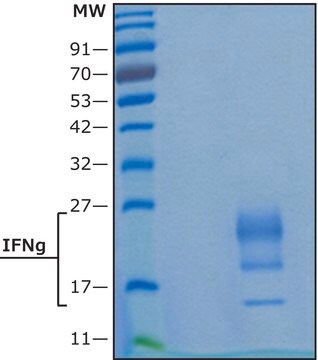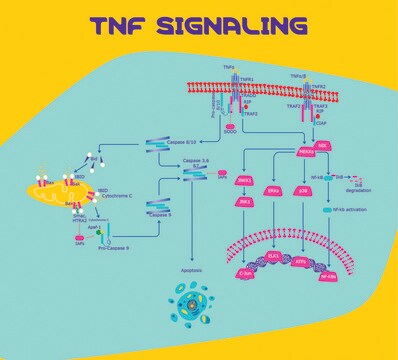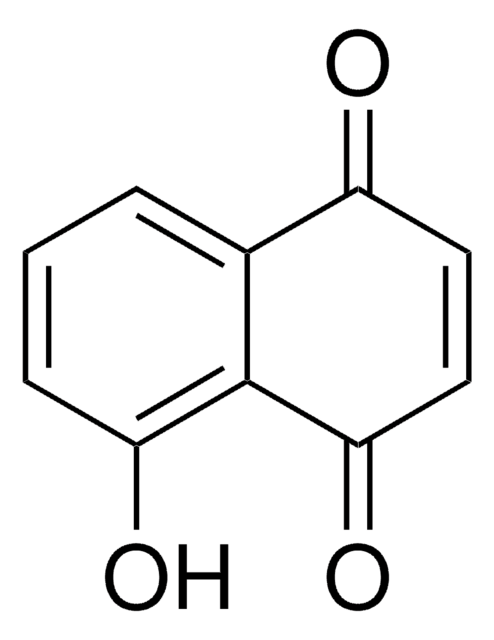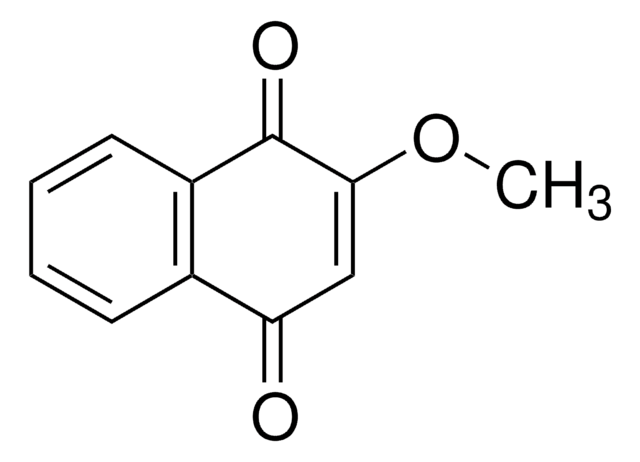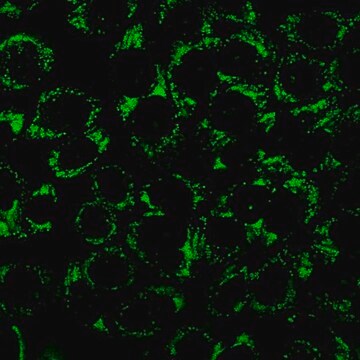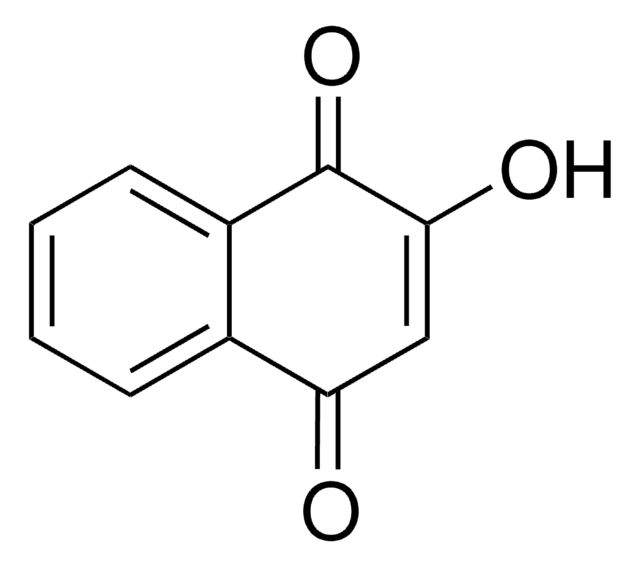D5439
2,3-Dimethoxy-1,4-naphthoquinone
≥99%, solid
Synonyme(s) :
DMNQ
Se connecterpour consulter vos tarifs contractuels et ceux de votre entreprise/organisme
About This Item
Formule empirique (notation de Hill) :
C12H10O4
Numéro CAS:
Poids moléculaire :
218.21
Numéro MDL:
Code UNSPSC :
12352200
ID de substance PubChem :
Nomenclature NACRES :
NA.77
Produits recommandés
Niveau de qualité
Essai
≥99%
Forme
solid
Température de stockage
−20°C
Chaîne SMILES
COC1=C(OC)C(=O)c2ccccc2C1=O
InChI
1S/C12H10O4/c1-15-11-9(13)7-5-3-4-6-8(7)10(14)12(11)16-2/h3-6H,1-2H3
Clé InChI
ZEGDFCCYTFPECB-UHFFFAOYSA-N
Application
2,3-Dimethoxy-1,4-naphthoquinone has been used to investigate the effects of ethanol on podocyte apoptosis under hypoxic and hyperoxic conditions.
Used to study the role of ROS in cell toxicity, apoptosis, and necrosis.
Actions biochimiques/physiologiques
2,3-dimethoxy-1,4-naphthoquinone (DMNQ) has the ability to produce H2O2 through redox cycling but fails to conjugate with glutathione (GSH).
Mention d'avertissement
Warning
Mentions de danger
Conseils de prudence
Classification des risques
Eye Irrit. 2 - Skin Irrit. 2 - STOT SE 3
Organes cibles
Respiratory system
Code de la classe de stockage
11 - Combustible Solids
Classe de danger pour l'eau (WGK)
WGK 3
Point d'éclair (°F)
Not applicable
Point d'éclair (°C)
Not applicable
Équipement de protection individuelle
dust mask type N95 (US), Eyeshields, Gloves
Faites votre choix parmi les versions les plus récentes :
Déjà en possession de ce produit ?
Retrouvez la documentation relative aux produits que vous avez récemment achetés dans la Bibliothèque de documents.
Les clients ont également consulté
Acute ethanol induces apoptosis by stimulating TRPC6 via elevation of superoxide in oxygenated podocytes
Lu X Y, et al.
Biochimica et Biophysica Acta - Molecular Cell Research, 1853(5), 965-974 (2015)
Anne R Diers et al.
Redox biology, 1, 1-7 (2013-09-12)
Nitric oxide production by the endothelium is required for normal vascular homeostasis; however, in conditions of oxidative stress, interactions of nitric oxide with reactive oxygen species (ROS) are thought to underlie endothelial dysfunction. Beyond canonical nitric oxide signaling pathways, nitric
Tindaro M Giardina et al.
Biochimica et biophysica acta, 1777(2), 118-129 (2007-12-18)
Uncoupling protein-2 (UCP2) is a member of the inner mitochondrial membrane anion-carrier superfamily. Although mRNA for UCP2 is widely expressed, protein expression is detected in only a few cell types, including macrophages. UCP2 functions by an incompletely defined mechanism, to
Richard Eugene Frye et al.
Scientific reports, 7(1), 4478-4478 (2017-07-02)
Mitoplasticity occurs when mitochondria adapt to tolerate stressors. Previously we hypothesized that a subset of lymphoblastoid cell lines (LCLs) from children with autistic disorder (AD) show mitoplasticity (AD-A), presumably due to previous environmental exposures; another subset of AD LCLs demonstrated
Valerie P Wright et al.
The Journal of physiology, 587(Pt 23), 5767-5781 (2009-10-21)
Skeletal muscles produce transient reactive oxygen species (ROS) in response to intense stimulation, disuse atrophy, heat stress, hypoxia, osmotic stress, stretch and cell receptor activation. The physiological significance is not well understood. Protein phosphatases (PPases) are known to be highly
Notre équipe de scientifiques dispose d'une expérience dans tous les secteurs de la recherche, notamment en sciences de la vie, science des matériaux, synthèse chimique, chromatographie, analyse et dans de nombreux autres domaines..
Contacter notre Service technique